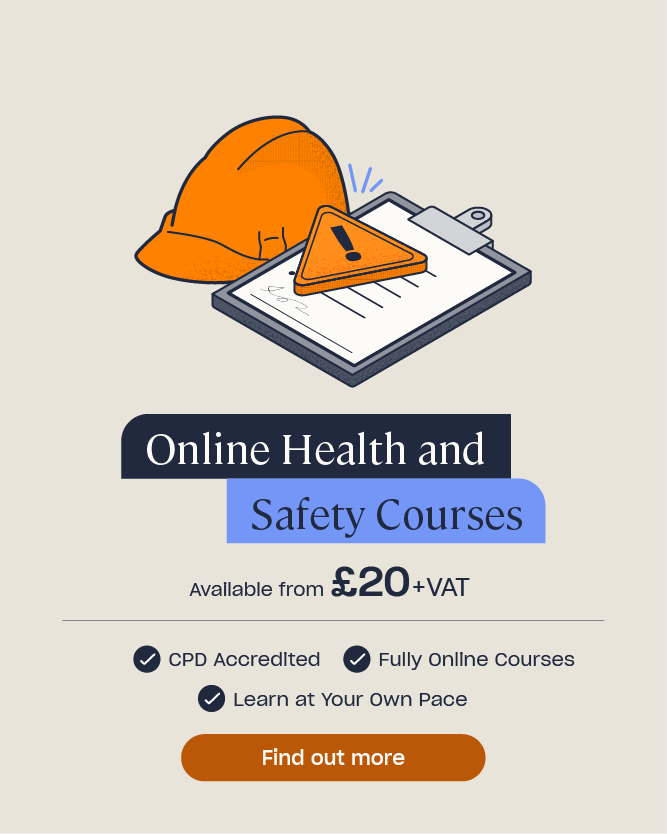HR Guide to Health & Safety – PDF Template
All businesses have a legal responsibility to ensure that their workplace has suitable health and safety arrangements in place so that everyone who works or visits there is protected from harm. However, knowing where to begin with this seemingly enormous task can be an intimidating prospect, so we’ve created this quick guide to health and safety procedures to help you understand more about what is needed.
What are My Responsibilities?
As a Human Resources Professional, it’s likely that creating and monitoring the workplace’s health and safety procedures is the responsibility of your department. This may seem like a daunting task but the process doesn’t need to be complicated nor time-consuming.
Your main responsibility is to ensure that people in the workplace are protected from harm.
This involves creating a health and safety policy (whether it’s 10 lines or 100 lines) and ensuring that everyone is educated well enough so that they can adhere to the policy with ease. Your aim is to ensure that health and safety procedures are suitable, sufficient and effective –and that’s it!
Need a Course?
Our range of Health & Safety Training ensures that you understand the most common health and safety risks in your workplace and the control measures that are needed to keep you safe. You can browse available courses from Health & Safety Training for Employees to Workplace First Aid Training.
What the Law Says
The main legislation governing health and safety at work is:
- The Management of Health and Safety at Work Regulations (MHSWR) 1999 – this requires you to have health and safety procedures in place.
- The Health and Safety at Work, etc Act 1974 – this requires you to prepare, implement and monitor a health and safety policy as well as carry out a risk assessment of the workplace.
The law states that you must have a ‘competent person’ involved in creating your health and safety procedures. This means that you must have access to someone with the necessary skills, knowledge and experience to manage health and safety correctly.
If you feel confident that you understand the workplace risks and know what to do to prevent them from causing harm – that’s great! That means you are the competent person and can create the health and safety policy. If you feel less confident, or your workplace is particularly high risk, then you may wish to ask for help and advice from someone with more knowledge – such as a fellow worker, your employer or an external health and safety expert.
What to Include in a Risk Assessment
Under health and safety legislation, all businesses must assess the risks in their workplace so that a plan can be put in place to control the risks. The aim is to identify anything that may cause harm to people and ensure actions are taken to prevent that from happening.
The risk assessment process is made up of 5 key steps. Your findings don’t need to be lengthy and you only need to include as much detail as you see fit – for example, a low risk office workplace will have far fewer hazards than a high risk chemical factory. The 5 steps of a risk assessment are:
- Identify the hazards.
- Decide who might be harmed and how.
- Evaluate the risks and implement controls.
- Record your findings.
- Review your assessment and update if necessary.
If there are five or more people in your workplace then it’s a legal requirement to have your risk assessment findings written down. For fewer than five people it’s not a requirement but is still recommended.
To make the process even easier, you can download a ready-made risk assessment template here.
What to Include in a Health and Safety Policy
You need to write a health and safety policy to ensure that everyone is on the same page when it comes to the identified health and safety procedures. The policy’s aim is to set out clear instructions for workers to follow so that they understand who is doing what, when and how. The policy needs to include:
- Your health and safety aims as a series of statements.
- Details of who is responsible for promoting each aim.
- The actions workers need to take in order to achieve the aims.
- A date and signature from the employer.
If your workplace has five or more employees then the policy must be written down, although it doesn’t need to be particularly lengthy: simple statements and a list of required actions are often all that are needed.
Use the findings from your risk assessment to decide upon the health and safety aims that will be part of the policy – the assessment will have informed you what the hazards are, who will be affected and which controls are needed.
It’s essential that everyone in your workplace has access to, and completely understands, the final health and safety policy. Email a copy of the completed policy round to each team member and then display a hard copy in the staff room or on a communal noticeboard so that people can easily see what their responsibilities are.
Employees are legally required to comply with health and safety procedures but they cannot do this if they aren’t given the correct instructions! Make sure each person knows what the aims are and understands their role in achieving them. Encourage people to ask you for more information if they’re unsure.
You can provide verbal, written and practical training and instructions as appropriate.
Managing the Health and Safety Procedures
So the risk assessment has been completed, the health and safety policy has been written and workers understand their responsibilities – but this isn’t the end of your duties!
Keeping an eye on the health and safety procedures to check their effectiveness is incredibly important as new hazards can arise all the time. There may be hazards that you’ve not considered previously or new employees, tasks and equipment may mean that a new risk assessment is needed.
Look to review your policy on a regular basis, such as every 6 months, plus make any necessary updates every time there is a change to the workplace. It’s also important to review the policy should someone have an accident whilst at work to find out whether your health and safety procedures remain sufficient.
Further Resources:
- Health & Safety Courses
- Health and Safety Signs Quiz
- Common Office Injuries and How to Prevent Them
- Workplace Health and Safety Quiz for Employees
- Managing Health and Safety Course











